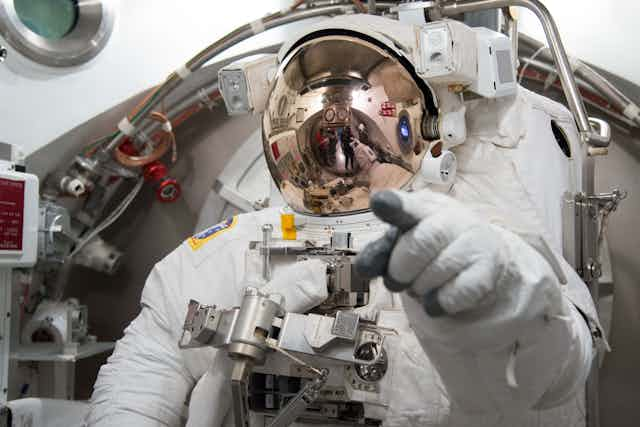At the Hawaii Space Exploration Analog and Simulation centre, NASA has just concluded the latest year-long study into the effects of long-term isolation in space. The research is primarily focused on examining psychological and psycho-social factors that will help NASA draw up the highly effective teams needed for long-duration space exploration missions. And among the behaviours studied is how aggression and violence might arise among space crews during long space voyages.
Crime and punishment are among the oldest problems faced by mankind. Immoral or illegal conduct has been a fixture in human history from the dawn of civilisation to the space age we live in today. It’s inevitable that it will at some point become an issue in space, so it’s important to be prepared for the eventuality. The question is how, or whether, terrestrial methods of inflicting violence can be used in space, and if so, whether terrestrial methods of criminal investigation are up to the job.

It’s thought that it is possible to fire handguns in space, and of course sharp stabbing or cutting weapons would work as they do on Earth, as would poisoning or attacks with bare hands. Astronauts have carried weapons on board space vessels since humanity first ventured into space.
There’s also the risk of tampering with or sabotage of the highly sensitive personal life support equipment and living quarters, laboratory and observatory facilities on board spacecraft. The survival of any spacecraft crew depends entirely on maintaining a habitable environment – if for some reason the cabin should depressurise, the astronauts’ blood would boil and turn to a gas. Malfunctions are not unheard of either – water leaks inside astronaut’s suits while outside the spacecraft have occurred on more than one occasion, and could have been fatal.
Space is a harsh enough environment as it is without any human malfeasance. Astronauts must contend with dangers from toxic gases released by dying stars and radiation levels that can cause cardiovascular diseases, to exposure to bacterial strains which can grow at twice the rate as on Earth. So we need to be able to distinguish between these natural effects and conduct that would be regarded as criminal on Earth.
CSI: Space
Crime scene examination is a joint scientific and investigative endeavour which requires investigators to assess crime scenes and other locations, identify evidence and use it to piece together what happened. In space, investigators must rely on not just forensic principles but also elements of astrophysics, chemistry and biology — because it’s all very different out there.
For example, biological samples such as blood, semen and other fluids are significant for forensic investigations. Tests have confirmed that DNA can survive in space for a limited time, and within habitable vessels and planetary settlements NASA has demonstrated the possibility of DNA sequencing. The vast amount of solar radiation is problematic, as fluids will lose heat rapidly in low or zero air pressure, freeze, and evaporate.
In enclosed locations, sweat can be expelled from crew-members and flung onto walls and equipment if they are moving due to weightlessness in space. If this sweat can be recovered before the condensate system recycles it into drinking water, it can be used as a source of DNA.
Blood spatter analysis
In microgravity liquids ball up and float around, restrained only by their surface tension, and blood pressure decreases resulting in loss of around a fifth of blood volume. If a crew-member’s body is cut, the physics of space would not allow for the same blood spatter patterns as seen on Earth. The likelihood is that blood would form spherical shapes like other liquids, either sticking to the victim or floating away from their source.
Reconstructing a crime scene from spatter pattern analysis would be incredibly complicated. The current mathematical equation used for such analysis would need changing to account for gravitational difference, and even then it would be of little reliability due to the fluid dynamics of space.
Ballistics
A gunshot fired in space would in all likelihood kill not merely from the impact of the bullet but the damage it would cause to someone’s space suit. With no air resistance or gravity, the ammunition’s casing expelled from the weapon would float away at speed, potentially a hazard itself. Fired at close quarters inside a spacecraft, a bullet could pass through a human body, through any bulkhead walls and continue to travel for vast distances through space. Without casing or bullet, it would be difficult to produce any useful ballistic analysis.

Fingerprint Evidence
Fingerprinting uses carbon or metal-based powders which stick to the moisture of prints left on physical surfaces, or through a method called superglue fuming where cyanoacrylate is heated in a container, and the resultant fumes bond with fingerprints on objects placed inside a enclosed container. Space physics means a method requiring enclosed spaces wouldn’t be a viable solution in a spacecraft, while a phenomenon called particle agglomeration, where particles such as dusting powder stick together, could render dusting techniques hard to implement in microgravity. One alternative is to replace dusting altogether and use laser scanning for fingerprinting.
Trace evidence and toxicology
Assuming environmental factors don’t make collection and storage unworkable, trace evidence can be analysed inside space laboratories equipped with mass spectrometry equipment, already used on remote stations, which can also be used to analyse poisons and toxins.
However, what these problems and their solutions require is real-world testing in space conditions. NASA has used the language of crime scene investigations in interesting education programmes, which approach the creation and expansion of the universe in terms of “space forensics” or as a “crime scene”. But there has been little actual research into the use of forensic science in space. NASA’s 2002 collaboration with the US National Institute of Justice to explore the use of space technology in Earth crime scenes was encouraging but the real focus should be on how forensic science from Earth would be implemented in space.

